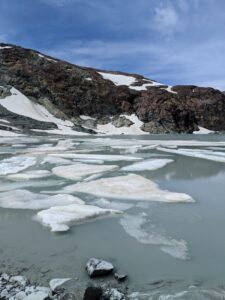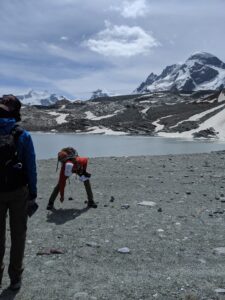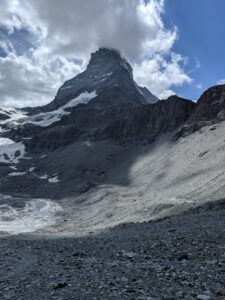Today we rose for breakfast and were on the road by 8:00. We had a full day of hiking and outdoor class discussions on the Matterhorn glacier trail hike. We started with an ear-popping ride up the gondola and began our hike by moving along the ridge and discussing the location where the remnants of “Theo” (the traveler passing over Theodul glacier) were found. Only his skull and a few other lower extremity bones were found, but through carbon dating analysis, scientists were able to learn so much about him. Standing there looking out over the spot where these remains were discovered, I tried to imagine how the terrain appeared when the Theo was traversing the Alps. The Theodul glacier had moved significantly from where Theo was when he met his fate. This really enunciated to me the systematic nature of a glacier. These magnificent systems move through time carrying hints of the past with them. Personally, I was amazed at how much we can learn about this man and the environment he experienced by only the few things we obtained from the site.

A large melt lake that formed in a glacier carved depression

Jeff teaching the class with graphs in the glacial sludge
I was already amazed at how much the landscape of glaciers can change overtime, but then the group hauled out these panorama photos from 2013 (6 years ago) and our objective was to find those same locations where the pictures were taken and observe how the glacier has changed since then. I was amazed at the recession. As we walked we also paid attention to the gradual recession of the glaciers through time. I couldn’t believe how much of the glacier used to tower above us in some of those locations. We stood near the base of the Matterhorn and in 1909, the glacier used to be as high as a 60 story building above us. Yet, in that spot, there was nothing but rock. I learned today that glaciers are not progressive and often are representative of the climate patterns from a decade earlier. Even if we stopped climate change now, we still would not make much difference in glacier recession, which is sad because we for sure are not stopping climate change.

The Matterhorn above the glacial valley where the Furgggletscher once was
The most moving part of the day was when we reached the top of the stream-filled valley where the Furgggletscher once was. Jeff made us reflect on the fact that glaciers actually don’t reflect the climate of the immediate present, but rather reflect 10 to 20 years prior. In thinking about this, I came to the conclusion that the glacier was demonstrative of climate in about 2000. It horrified me to realize that we are doing the same things we were doing in 2000, especially being able to see the hill of rocks that was supposed to be a grand glacier in the background. Although some day the valley left behind will be some beautiful meadow, the sheer power of our impact on a climate that is supposed to be cooling verges on being incomprehensible.
P.S. Due to formatting issues, it was not possible to post the before and after photos from our picture hunt. However, there are official before and after photos available at this link.